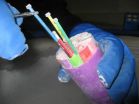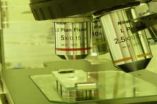(Press-News.org) Highlights
Home hemodialysis could allow patients to enjoy increased freedom, quality of life, greater ability to travel, and tangible health improvements.
Increased physician and patient education can eliminate barriers to home hemodialysis and increase its use.
Approximately 2 million patients in the world receive some sort of dialysis treatment.
Washington, DC (October 4, 2012) — Most patients with chronic kidney disease who undergo hemodialysis put up with a grueling treatment regimen that involves going into a clinic several days a week and sitting through a three-to-four hour dialysis session at each visit. Home hemodialysis is more accessible than ever, though, with the advent of newer systems that are easier for patients to learn, use, and maintain, according to a review appearing in an upcoming issue of the Clinical Journal of the American Society of Nephrology (CJASN). The authors offer suggestions for how to overcome barriers and establish a successful home hemodialysis program.
"There is virtually no other disease that requires patients to make such considerable changes in their lifestyle as a diagnosis of end-stage renal disease and the need for dialysis therapy does," said Rajnish Mehrotra, MD (University of Washington, Seattle). "To ease the challenge associated with such a diagnosis, offering patients choice allows them to select a dialysis therapy that best fits into their lifestyle and their expectations."
Home hemodialysis is one type of dialysis therapy, but it is available to less than 2% of dialysis patients in the country. Home hemodialysis requires extensive patient training, nursing education, and infrastructure support to maintain a successful program. Also, reluctance to start such programs is widespread because many physicians do not have experience with home hemodialysis.
Bessie Young, MD (University of Washington, Seattle) worked with Dr. Mehrotra and others to provide an in-depth review to describe the benefits and barriers to home hemodialysis, focusing on patients, physicians, practices, and dialysis facilities.
Benefits of home hemodialysis include:
Potential for greater dialysis delivery (more frequent or overnight treatments)
Improved quality of life
Patient independence and employment potential
Greater ability to travel
20%-50% less costly than in-center hemodialysis depending on the machine.
Barriers to home hemodialysis include:
Lack of patient awareness and education about home hemodialysis
Patients' perceptions, including fear of change and lack of self-confidence
Physicians' education about home hemodialysis
Machine complexity, which is now minimal with newer, easier-to-use systems
Inadequate payment to providers for home hemodialysis training.
"Home hemodialysis has been successfully used by thousands of patients and should be available to everyone on or initiating dialysis. It is a safe, efficient modality that allows patients the ability to increase their frequency of dialysis, which may provide a potential survival benefit," said Dr. Young.
###Study co-authors include Christopher Chan, MD, Christopher Blagg, MD, Robert Lockridge, MD, Thomas Golper, MD, Fred Finkelstein, MD, Rachel Shaffer, and Rajnish Mehrotra on behalf of the ASN Dialysis Advisory Group (DAG).
Disclosures: Christopher Chan serves as a member of the scientific advisory board for Baxter Healthcare. Christopher Blagg is a consultant to DEKA Research and Development Corporation. Robert Lockridge serves as a member of the scientific advisory board for Fresenius Medical Care. Thomas Golper conducts consultant activity for Baxter, Fresenius, DaVita, Takeda-Affymax, and Q Source. Fredric Finkelstein serves as a member of the scientific advisory board for NxStage and conducts consultant activity for Baxter Healthcare. Rachel Shaffer is an employee of the American Society of Nephrology. Rajnish Mehrotra has received grant support and/or honoraria from Baxter Healthcare, DaVita, Mitsubishi, Shire, Takeda, and Vifor.
The article, entitled "How to Overcome Barriers and Establish a Successful Home HD Program," will appear online at http://cjasn.asnjournals.org/ on October 4, 2012, doi: 10.2215/CJN.07080712.
The content of this article does not reflect the views or opinions of The American Society of Nephrology (ASN). Responsibility for the information and views expressed therein lies entirely with the author(s). ASN does not offer medical advice. All content in ASN publications is for informational purposes only, and is not intended to cover all possible uses, directions, precautions, drug interactions, or adverse effects. This content should not be used during a medical emergency or for the diagnosis or treatment of any medical condition. Please consult your doctor or other qualified health care provider if you have any questions about a medical condition, or before taking any drug, changing your diet or commencing or discontinuing any course of treatment. Do not ignore or delay obtaining professional medical advice because of information accessed through ASN. Call 911 or your doctor for all medical emergencies.
Founded in 1966, and with more than 13,500 members, the American Society of Nephrology (ASN) leads the fight against kidney disease by educating health professionals, sharing new knowledge, advancing research, and advocating the highest quality care for patients.
There's no place like home -- For dialysis
New home hemodialysis systems are easier for kidney disease patients to use
2012-10-05
ELSE PRESS RELEASES FROM THIS DATE:
Dating encounters between modern humans and Neandertals
2012-10-05
To discover why Neandertals are most closely related to people outside Africa, Harvard and Max Planck Institute scientists have estimated the date when Neandertals and modern Europeans last shared ancestors. The research, published in the journal PLOS Genetics, provides a historical context for the interbreeding. It suggests that it occurred when modern humans carrying Upper Paleolithic technologies encountered Neandertals as they expanded out of Africa.
When the Neandertal genome was sequenced in 2010 it revealed that people outside Africa share slightly more genetic ...
BPA's real threat may be after it has metabolized
2012-10-05
Bisphenol A or BPA is a synthetic chemical widely used in the making of plastic products ranging from bottles and food can linings to toys and water supply lines. When these plastics degrade, BPA is released into the environment and routinely ingested.
New research, however, from the University of California, San Diego School of Medicine suggests it is the metabolic changes that take place once BPA is broken down inside the body that pose the greater health threat.
More than 90 percent of all Americans are believed to carry varying levels of BPA exposure.
In recent ...
Insects shape the genetic landscape through plant defenses
2012-10-05
As restaurant patrons' diverse food preferences give rise to varied menu offerings, so plant-eating insects' preferences play an important role in maintaining and shaping the genetic variation of their host plants in a geographic area, reports an international team of researchers that includes a plant scientist at the University of California, Davis.
The new study, involving aphids and the broccoli-like research plant Arabidopsis thaliana, provides the first measureable evidence that this selective process is driven, in part, by the pressure that multiple natural enemies ...
14 new biomarkers identified for type 2 diabetes
2012-10-05
Potsdam-Rehbruecke/Berlin – A research team led by Anna Floegel of the German Institute of Human Nutrition (DIfE) and Tobias Pischon of the Max Delbrueck Center for Molecular Medicine (MDC) has identified 14 novel biomarkers for type 2 diabetes. They can serve as basis for developing new methods of treatment and prevention of this metabolic disease. The biomarkers can also be used to determine diabetes risk at a very early point in time. At the same time the markers enable insight into the complex mechanisms of this disease, which still have not been completely elucidated. ...
Asteroid fragments could hint at the origin of the solar system
2012-10-05
The tiny pieces of rock – at 50-100 micrometers smaller than a human hair – have been captured from asteroid Itokawa by the Japanese mission Hayabusa. They were carefully unpacked by experts at the University's School of Earth, Atmospheric and Environmental Sciences.
It is the first time samples from an asteroid have been returned to Earth. Only about 70 samples have been released for international analysis – seven of these are being studied at the University.
The Hayabusa mission is part of a continuing effort to understand how asteroids, which are leftovers from ...
Everyday evolution
2012-10-05
Take a good look around on your next nature hike. Not only are you experiencing the wonders of the outdoors – you're probably also witnessing evolution in action.
New research from the University of Toronto Mississauga (UTM) on the effect of insects on plant populations has shown that evolution can happen more quickly than was previously assumed, even over a single generation. The study is to be published in the Oct. 5 issue of Science.
"Scientists have long hypothesized that the interaction between plants and insects has led to much of the diversity we see among plants, ...
Abortion rates plummet with free birth control
2012-10-05
Providing birth control to women at no cost substantially reduced unplanned pregnancies and cut abortion rates by 62 percent to 78 percent over the national rate, a new study shows.
The research, by investigators at Washington University School of Medicine in St. Louis, appears online Oct. 4 in Obstetrics & Gynecology.
Among a range of birth control methods offered in the study, most women chose long-acting methods like intrauterine devices (IUDs) or implants, which have lower failure rates than commonly used birth control pills. In the United States, IUDs and implants ...
How ketamine defeats chronic depression
2012-10-05
Many chronically depressed and treatment-resistant patients experience immediate relief from symptoms after taking small amounts of the drug ketamine. For a decade, scientists have been trying to explain the observation first made at Yale University.
Today, current evidence suggests that the pediatric anesthetic helps regenerate synaptic connections between brain cells damaged by stress and depression, according to a review of scientific research written by Yale School of Medicine researchers and published in the Oct. 5 issue of the journal Science.
Ketamine works on ...
UCLA astronomers discover star racing around black hole at center of our galaxy
2012-10-05
UCLA astronomers report the discovery of a remarkable star that orbits the enormous black hole at the center of our Milky Way galaxy in a blistering 11-and-a-half years — the shortest known orbit of any star near this black hole.
The star, known as S0-102, may help astronomers discover whether Albert Einstein was right in his fundamental prediction of how black holes warp space and time, said research co-author Andrea Ghez, leader of the discovery team and a UCLA professor of physics and astronomy who holds the Lauren B. Leichtman and Arthur E. Levine Chair in Astrophysics. ...
Climate sceptics more prominent in UK and US media
2012-10-05
Climate sceptics are being given a more prominent, and sometimes uncontested, voice in UK and US newspapers in contrast to other countries around the world, new research suggests.
The findings have been published today, 5 October, in IOP Publishing's journal Environmental Research Letters, as part of a study looking at how climate scepticism manifested itself in the print media of the US, UK, Brazil, China, India and France during a 3-month period which included 'Climategate' in 2009/10 and a second period which covered the IPCC's Fourth Assessment Report in 2007.
In ...
LAST 30 PRESS RELEASES:
Making lighter work of calculating fluid and heat flow
Normalizing blood sugar can halve heart attack risk
Lowering blood sugar cuts heart attack risk in people with prediabetes
Study links genetic variants to risk of blinding eye disease in premature infants
Non-opioid ‘pain sponge’ therapy halts cartilage degeneration and relieves chronic pain
AI can pick up cultural values by mimicking how kids learn
China’s ecological redlines offer fast track to 30 x 30 global conservation goal
Invisible indoor threats: emerging household contaminants and their growing risks to human health
Adding antibody treatment to chemo boosts outcomes for children with rare cancer
Germline pathogenic variants among women without a history of breast cancer
Tanning beds triple melanoma risk, potentially causing broad DNA damage
Unique bond identified as key to viral infection speed
Indoor tanning makes youthful skin much older on a genetic level
Mouse model sheds new light on the causes and potential solutions to human GI problems linked to muscular dystrophy
The Journal of Nuclear Medicine ahead-of-print tip sheet: December 12, 2025
Smarter tools for peering into the microscopic world
Applications open for funding to conduct research in the Kinsey Institute archives
Global measure underestimates the severity of food insecurity
Child survivors of critical illness are missing out on timely follow up care
Risk-based vs annual breast cancer screening / the WISDOM randomized clinical trial
University of Toronto launches Electric Vehicle Innovation Ontario to accelerate advanced EV technologies and build Canada’s innovation advantage
Early relapse predicts poor outcomes in aggressive blood cancer
American College of Lifestyle Medicine applauds two CMS models aligned with lifestyle medicine practice and reimbursement
Clinical trial finds cannabis use not a barrier to quitting nicotine vaping
Supplemental nutrition assistance program policies and food insecurity
Switching immune cells to “night mode” could limit damage after a heart attack, study suggests
URI-based Global RIghts Project report spotlights continued troubling trends in worldwide inhumane treatment
Neutrophils are less aggressive at night, explaining why nighttime heart attacks cause less damage than daytime events
Menopausal hormone therapy may not pose breast cancer risk for women with BRCA mutations
Mobile health tool may improve quality of life for adolescent and young adult breast cancer survivors
[Press-News.org] There's no place like home -- For dialysisNew home hemodialysis systems are easier for kidney disease patients to use




